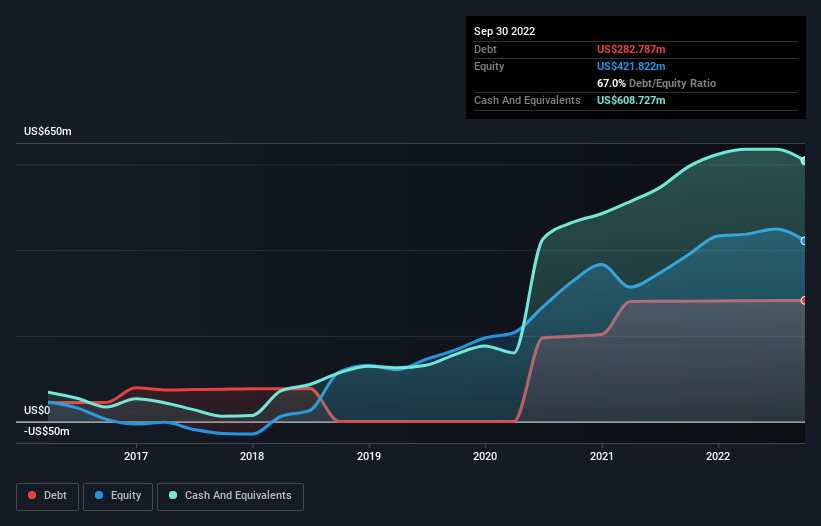- United States
- /
- Medical Equipment
- /
- NasdaqGM:TNDM
Is Tandem Diabetes Care (NASDAQ:TNDM) Using Debt In A Risky Way?

Howard Marks put it nicely when he said that, rather than worrying about share price volatility, 'The possibility of permanent loss is the risk I worry about... and every practical investor I know worries about.' When we think about how risky a company is, we always like to look at its use of debt, since debt overload can lead to ruin. We can see that Tandem Diabetes Care, Inc. (NASDAQ:TNDM) does use debt in its business. But the real question is whether this debt is making the company risky.
What Risk Does Debt Bring?
Debt assists a business until the business has trouble paying it off, either with new capital or with free cash flow. In the worst case scenario, a company can go bankrupt if it cannot pay its creditors. While that is not too common, we often do see indebted companies permanently diluting shareholders because lenders force them to raise capital at a distressed price. Of course, plenty of companies use debt to fund growth, without any negative consequences. The first thing to do when considering how much debt a business uses is to look at its cash and debt together.
See our latest analysis for Tandem Diabetes Care
How Much Debt Does Tandem Diabetes Care Carry?
The chart below, which you can click on for greater detail, shows that Tandem Diabetes Care had US$282.8m in debt in September 2022; about the same as the year before. But it also has US$608.7m in cash to offset that, meaning it has US$325.9m net cash.

How Strong Is Tandem Diabetes Care's Balance Sheet?
Zooming in on the latest balance sheet data, we can see that Tandem Diabetes Care had liabilities of US$173.6m due within 12 months and liabilities of US$452.1m due beyond that. Offsetting this, it had US$608.7m in cash and US$112.8m in receivables that were due within 12 months. So it can boast US$95.8m more liquid assets than total liabilities.
This surplus suggests that Tandem Diabetes Care has a conservative balance sheet, and could probably eliminate its debt without much difficulty. Succinctly put, Tandem Diabetes Care boasts net cash, so it's fair to say it does not have a heavy debt load! The balance sheet is clearly the area to focus on when you are analysing debt. But it is future earnings, more than anything, that will determine Tandem Diabetes Care's ability to maintain a healthy balance sheet going forward. So if you're focused on the future you can check out this free report showing analyst profit forecasts.
Over 12 months, Tandem Diabetes Care reported revenue of US$791m, which is a gain of 20%, although it did not report any earnings before interest and tax. We usually like to see faster growth from unprofitable companies, but each to their own.
So How Risky Is Tandem Diabetes Care?
Although Tandem Diabetes Care had an earnings before interest and tax (EBIT) loss over the last twelve months, it generated positive free cash flow of US$21m. So although it is loss-making, it doesn't seem to have too much near-term balance sheet risk, keeping in mind the net cash. With mediocre revenue growth in the last year, we're don't find the investment opportunity particularly compelling. When analysing debt levels, the balance sheet is the obvious place to start. However, not all investment risk resides within the balance sheet - far from it. Case in point: We've spotted 1 warning sign for Tandem Diabetes Care you should be aware of.
At the end of the day, it's often better to focus on companies that are free from net debt. You can access our special list of such companies (all with a track record of profit growth). It's free.
Valuation is complex, but we're here to simplify it.
Discover if Tandem Diabetes Care might be undervalued or overvalued with our detailed analysis, featuring fair value estimates, potential risks, dividends, insider trades, and its financial condition.
Access Free AnalysisHave feedback on this article? Concerned about the content? Get in touch with us directly. Alternatively, email editorial-team (at) simplywallst.com.
This article by Simply Wall St is general in nature. We provide commentary based on historical data and analyst forecasts only using an unbiased methodology and our articles are not intended to be financial advice. It does not constitute a recommendation to buy or sell any stock, and does not take account of your objectives, or your financial situation. We aim to bring you long-term focused analysis driven by fundamental data. Note that our analysis may not factor in the latest price-sensitive company announcements or qualitative material. Simply Wall St has no position in any stocks mentioned.
About NasdaqGM:TNDM
Tandem Diabetes Care
Designs, develops, and commercializes technology solutions for people living with diabetes in the United States and internationally.
Undervalued with excellent balance sheet.

